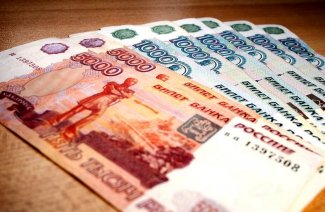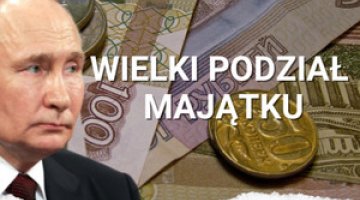Russian economy in 2022. Adaptation and a growing budget gap

Russia’s macroeconomic performance in 2022 confounded forecasts from one year ago, a few weeks after the invasion of Ukraine. However, in wartime conditions, indicators such as GDP do not accurately reflect the real state of the economy, due to the rapidly increasing military expenditure, the scale of the ongoing changes and major differences between individual sectors. Furthermore, the credibility of the published macroeconomic data is declining and the government has been restricting access to statistical data.
The first months of 2022, when Russian companies generated high profits, had a considerable impact on the country’s economic performance. The situation began to deteriorate due to the mobilisation in autumn, the further escalation of hostilities and, above all, due to the imposition of EU sanctions against the Russian oil sector, which became effective on 5 December 2022. This had the greatest impact on public finances. The increasing military expenses have caused a large budget deficit. Although the Kremlin is still able to finance the gap, it will find it increasingly challenging to cope with declining revenues, especially in the oil and gas sectors.
Last year, both Russian business and the Russian public demonstrated significant adaptive potential. This made stabilising the economic situation in the country much easier. The government had been escalating repressions, and people outside the Kremlin’s inner circle were aware of the threat of losing their assets. Therefore, Russian business circles not only did not protest against the war and the resulting business losses, but have also adapted to the new reality and actively joined the process of 'technological transformation' (as the head of the Central Bank of Russia (CBR) calls the continuing technological regression in the country). The past year has led to intensifying government control of the economy and to strengthening the current economic model: state capitalism with all its pathologies, such as corruption, the consolidation of assets in the hands of the president’s entourage and a biased judicial system.
According to the first assessment from Rosstat,[1] Russia’s GDP in 2022 decreased by 2.1% (before the invasion, 3% growth was forecast). In the first weeks of the war, considering the massive sanctions imposed by the West, it was expected that the Russian economy could contract by over 10%. Even though the accuracy of the statistics presented by the Russian authorities is questionable, Russia has really managed to avoid sharp declines for a number of reasons. For example, the Kremlin managed to limit the negative consequences (devaluation of the rouble and inflation) of the financial sanctions imposed in the first days after the invasion. This was possible due to very high revenues from exports of oil and gas (restrictions on Russian exports were implemented a few months later) and the measures taken by the CBR, including restricting the convertibility of the rouble. The accumulated reserves and cooperation with intermediaries from countries that did not join the sanctions, enabled Russian companies to continue production despite corporate boycotts, being cut off from imports and the disruption of logistics chains. As a result, Russia slipped into crisis gradually (the most difficult situation occurred at the turn of 2022 and 2023), but the crisis will last longer. Most forecasts also predict a decline in Russian GDP this year: for example, the World Bank has predicted a 3% fall. However, there are also positive forecasts. The IMF has predicted a 0.3% increase in Russia’s GDP.
The good performance of agriculture and the construction sector contributed to a considerably slower decline in Russia’s GDP. In 2022, the value of agricultural production increased by more than 10%. 154 million tonnes of grain were harvested, that is 27% more than a year before. This included 104 million tonnes of wheat (an increase of 37% y/y). The good crops and the limited food exports in the preceding agricultural season (1 July 2021 – 30 June 2022), in which 38 million tonnes of grain were exported (11 million tonnes less than a year earlier), led to oversupply on the domestic market and price drops. Only a small group of companies, largely controlled by the Kremlin elite, can export grain. In addition, the state collects an export duty, which reduces the competitiveness of Russian produce.
The construction sector also achieved good results, although these data are rather controversial. Last year, the value of construction work officially increased by 5%. Government support programmes, such as preferential mortgages and the renovation of old residential buildings, have strongly contributed to this result. Almost 8% of all construction work was financed from state funds. Since the middle of the year, however, the industry has been less active, which is evidenced especially by the number of apartments completed. This number grew by 11% y/y in 2022 as a whole. However, in December a 17% decrease y/y was reported. The rapid growth rates are contrasted with the data presented, for example, by Severstal (one of Russia’s largest metallurgical companies), which reported a 4% decline in supplies of metal products to the construction sector. The industry’s results could also have been inflated by legal changes, such as expanding the simplified procedure for the technical acceptance of buildings, including summer houses, which had in reality been built much earlier.
Another factor which helped Russian companies keep production going was a significant increase in budget spending in 2022 (by about 5% of GDP). However, it is unlikely that intensified budget spending will be able to contribute to long-term economic growth in the country. This applies especially to expenditure on war and investments in the import substitution process (past experience shows that goods produced in Russia as part of import substitution programmes are usually much more expensive and of inferior quality to those from other countries).
Russian business, supported by the state, has increased investments despite the ongoing economic crisis. The factors which contributed to this included: the need to adapt to the new economic reality, including changes in suppliers and goods, the technological regression and the creation of new logistics chains. In the first nine months of 2022 (data for Q4 are not available) investments grew almost 6% y/y. For example, Gazprom’s investment expenditure increased in 2022 by 100% y/y (to over $30 billion). This was linked to the need to expand its export potential in the eastern direction (the expansion of the Power of Siberia gas pipeline leading to China and further development of the gas fields which supply it) and the gasification of the Russian regions.
Falling consumer demand, which fell back by about 4% in 2022, was dragging down the country’s economy. Retail trade volume decreased significantly (by approx. 7%). This was due to the unclear prospect of developments in the country, which prevented citizens from making purchases (especially of industrial goods), and the migration of the middle class, which had been the driving force behind consumption in large cities. Due to the increase in tariffs, the Russian public was forced to spend more on services (especially on transport and municipal and housing fees). Interestingly, however, the turnovers of restaurants and bars increased, which could be due to the fact that many Russians decided not to go abroad for holidays.
The limited demand and the measures taken by the Russian government (including raising interest rates and strengthening the rouble) have contributed to a slowdown in inflation. At the end of the year, it was below 12%. In the last months of 2022, however, prices began to grow again. The CBR is concerned about inflation pressure, especially due to the rapidly growing budget spending.
The prices of industrial goods, especially those imported or produced using parts from abroad, increased most of all. At the end of the year, the tariffs of public services (transport, municipal and housing fees) also began to rise. Many Russians complain that the perceived inflation has been much higher than that reported by Rosstat. In addition, in their opinion, the quality of many goods has deteriorated and the range has decreased.
The situation varied greatly, depending on the industry. Annual industrial production officially decreased by only about 0.5% y/y. This was mainly due to very good results achieved in the first months of the year, as well as government procurement for war needs (this applies to the machine-building, textile and food industries and others). The extractive industry sector generated a slight increase (production of the oil sector grew 2% y/y)[2] mainly due to the postponement of the EU embargo on imports of Russian oil until the end of the year. However, in February this year the government announced a 'voluntary' reduction in daily oil production by 0.5 million barrels, i.e. by almost 5%, in response to the difficulties in finding importers, especially for Russian petroleum products.
However, sharp declines were seen in sectors subject to sanctions or counter-sanctions. First of all, there was a production breakdown in the automotive industry affected by corporate boycotts. Import restrictions, the closure of airspace for Russian carriers and the fact that they were cut off from spare parts and Western services (including leasing) have resulted in a decline in air freight. Government programmes aimed at supporting domestic tourism and subsidising tickets mean that passenger transport has decreased to a much lesser extent.
The Kremlin used gas supplies to blackmail the European Union, which has led to a serious drop in gas exports (by approximately 45%) to the European market, and consequently to a reduction in natural gas output. Gazprom was particularly affected, as it extracted 20% less gas (at the end of the year, the company stopped publishing data on exports and extraction[3]). The nearly 25% decline in the value of services provided to the oil and gas industry due to the withdrawal of foreign companies from Russia poses a major threat to the future of the Russian energy sector. The foreign partners played a key role, especially in the process of field exploitation.
An analysis of the falling turnover of companies from individual sectors provides a fuller picture of the Russian economy. It turns out that in many cases the falls were more serious than the reduction in production volumes alone could suggest. The situation in the individual regions of Russia was also very diverse. In 2022, industrial production was shrinking in the areas which heavily rely on the automotive sector, i.e. Kaluga Oblast (by 20%) and Kaliningrad Oblast (by 18%), and on the timber industry, e.g. Karelia (by 9%). An increase was seen in regions linked to the arms sector, such as Bryansk Oblast (by 18%), with the energy sector, such as the Nenets Autonomous Okrug (by 12%), or with both sectors at the same time, such as with Tatarstan (by 6%).
As the prices of natural resources on global markets remained high and Russia managed to continue exporting large volumes of them, especially in the first half of last year, it was able to generate considerable revenue, despite the fact that imports were limited due to sanctions. According to data published by the CBR, the country’s revenues from exports of goods and services exceeded $628 billion in 2022, which was 14% more than a year earlier (since spring 2022, the CBR has published only aggregated data on the balance of payments). The value of imports fell 9% to $346 billion. Since the middle of the year, when the sanctions on Russian exports (metals, wood, coal, oil) became effective, foreign supplies have gradually decreased. At the same time, the intensification of relations with non-Western countries, mainly China, helped to lift the volumes of Russian imports. However, it is not known to what extent this was an effect of the rising prices of imported goods.
In turn, the mirror data of Russia’s key trading partners show that China (with a 12% increase in exports y/y) and Turkey (an 80% increase) accounted for the largest upsurge in supplies of goods to Russia in 2022. At the same time, Western countries reduced exports of goods to Russia: the European Union cut its deliveries by over 35% (data for the first 11 months of 2022), the USA by 70%, and the United Kingdom by 80%.
The value of Russian exports grew mainly in China (by 45%), Turkey (by 120%) and India (by 400%, mainly crude oil was exported). Exports to the EU were also higher (by 35%), which was due to the high prices of energy resources, especially in the first half of the year. In turn, exports to the USA and the UK fell significantly, by 50% and 60%, respectively.
As a result, Russia achieved a record-high current account surplus of $227.5 billion in 2022, though this was rapidly disappearing at the end of the year. In December, it was only $1.7 billion (while in November it was $10 billion). In turn, in January 2023 it rose again to reach $8 billion. It is not known whether this was linked to the continuing flow of export revenues or to the usual decline in imports in the first months of the year.
The Russian currency got stronger in 2022. The US dollar average exchange rate was 68.5 roubles, compared to 73.7 roubles a year earlier. However, the reduced inflow of petrodollars to the country and growing imports made the Russian currency weaken in the fourth quarter.
According to data published by the Ministry of Finance of the Russian Federation, despite the drop in the prices of Russian export goods in the second half of 2022, annual budget revenues turned out to be 2.5 trillion roubles (10%) higher than in 2021. This was possible mainly due to the heavier levies imposed on Gazprom. The company became the largest contributor to public finances. It paid over 5 trillion roubles (almost $73 billion) to the federal and regional budgets, including 1.2 trillion roubles in an additional, one-off extraction tax (paid in three equal instalments). In addition, Gazprom paid a dividend for the first half of 2022 in autumn (earlier than usual, as so far it had paid it just once a year). This meant it contributed another 600 billion roubles to the budget. As a result, payments from Gazprom replaced the falling regular revenues from the oil and gas sector. The Kremlin also imposed higher taxes on the oil, coal, metallurgical and mineral fertilisers sectors. The introduction of the EU’s embargo on crude oil (on 5 December) and setting a price cap on seaborne Russian oil products sold to non-Western countries severely affected the Russian budget. The average price of a barrel of Russian Urals oil, which is key to the Russian budget, dropped to about $50 in January 2023.
At the same time, the Kremlin was rapidly increasing budget spending. In 2022, it was 25% higher than the previous year. It is speculated that national defence expenditure grew at least 30% (since spring 2022, the government has not published more specific expenditure data). Expenditure was distributed unevenly throughout the year: over 20% of all the allocated funds were spent in December.
As a result, in 2022, Russia generated a budget deficit of 3.3 trillion roubles, i.e. 2.3% of GDP. This shortfall was financed to a large extent by the National Wealth Fund (NWF) which allocated almost 3 trillion roubles for this purpose. To be able to pay the growing liabilities, the government issued bonds worth 2.3 trillion roubles, which were bought by state-owned banks. At the end of the year, the internal debt rose to almost 19 trillion roubles, i.e. about 13% of GDP.
At the beginning of 2023, the price of Urals oil fell even lower, which was a serious blow to the Russian budget. Oil and gas revenues fell almost 45% in January, resulting in a 35% drop in total budget revenues. As a consequence, the government had to take more money from the NWF to offset the shortages. At the same time, the Russian government decided to change its spending policy. In January the government disbursed part of the funds in advance (more than 1.4 trillion rubles) planned for public procurement, including those for defence. In total, almost 5 trillion roubles have been reserved for public procurement in 2023. As a rule, these funds had not reached the economy until the end of the year. As a result, 10% of all expenditure planned for the current year were already distributed in January. The government has planned to close 2023 with a budget deficit of 3 trillion roubles (about 2% of GDP), assuming that the average oil barrel price will be $70. Therefore, if it remains at the current level (around $50), the deficit may increase by another 2 trillion roubles. Limiting crude oil output may make the budget gap even bigger. In addition, it is uncertain whether the increase in spending in January is merely the result of prepayments in public procurement or a sign of a further increase in public spending. As experience shows, the budget law is not a limitation for the government, and the level of state expenditure is determined by the president. In recent months, the government has been looking for additional sources of financing. For example, heavier public levies have been imposed on the oil and gas sector in 2023. The Ministry of Finance has also announced that, starting from 1 April this year, a new method will be applied to calculate the average price of Urals oil, which is used as the baseline for taxing oil companies (currently it is based on market estimates by the Argus agency). It will be determined on the basis of the Brent oil price benchmark minus the adjustable discount size: in April it will be $34 per barrel, in May $31, in June $28, and starting from July, it will be $25. This move may lead to imposing still heavier levies on the sector. The Kremlin is also considering taking a significant part of the profits from state-owned companies in the form of dividends. The government's latest proposal demonstrates how tough the budget situation is. It has suggested imposing a 'voluntary' one-off payment on profits generated by large businesses in 2022 (according to Rosstat estimates, Russian business had a net profit of 20 trillion roubles during the first nine months of 2022, but at the end of the year the figures were plummeting).
The National Wealth Fund, which plays a key role in the process of financing the budget deficit and adapting business to the new economic reality, is shrinking quite rapidly. At the end of the year, it stood at 10.4 trillion roubles. This included 6.1 trillion roubles of liquid assets, i.e. those available to the government. After Western countries froze the NWF’s foreign assets, their structure has changed. Currently, the fund’s resources are deposited in yuan and gold. This was possible due to technical financial operations made by the CBR, which transferred the ‘toxic’ assets in Western currencies to its accounts, offering the government yuan in return.
In 2022, a record-high outflow of capital, of over $250 billion, was observed in Russia. This was mainly the effect of individual clients transferring their savings outside the country. The value of Russian citizens’ deposits in foreign banks has more than doubled, reaching about $82 billion. Russian corporate entities, mainly business companies, have also reduced their foreign liabilities. Throughout 2022, the debt was reduced by $100 billion dollars.
According to Rosstat, the real income of the Russian public decreased in 2022 by only 1%, and the downward trend was reversed in the last quarter of the year. However, it still remains about 10% lower than in 2013, before the annexation of Crimea. Rosstat’s calculations of this indicator typically raise many doubts, especially since last year citizens’ real wages were cut by almost 2% (in the first 11 months of the year), and pensions by up to 6% (taking into account the one-off, pre-election payment in September 2021). According to Rosstat, the rise seen in the fourth quarter was due to increased business income and public welfare payments, probably largely linked to mobilisation to the army and compensation for wounded soldiers and the families of those killed at the front.
In 2022, the number of economically active individuals decreased by 0.5% (i.e. by over 400,000) to 74.9 million people, and the number of the employed population increased by 0.4% (260,000, this is partly an effect of the pension reform being implemented). It should be added that those serving in the army are treated as part of the employed population. The unemployment rate in the country remained low: in December it was 3.7%, which means that about 2.8 million people were unemployed. Part-time workers make up a large proportion of the figures; the latest available data for the third quarter of 2022 indicated that more than 4.6 million people were employed part-time (more than during the pandemic). To a large extent, this was related to the withdrawal of Western companies from Russia. Human capital is a serious problem for the Russian economy, which is adapting to the new conditions, but above all it will be a major barrier to development in the long run. Many industries (e.g. construction) are already experiencing labour shortages, especially as the flow of labour migrants from neighbouring countries has shrunk. The mobilisation and mass emigration of people unwilling to fight in Ukraine might have deprived the labour market of about 2-4% of men aged 20-39, i.e. the most productive social group. Less educated men from small towns and villages were predominant among those who were sent to war, and they are particularly needed in industry, which is struggling with the growing labour intensity of production due to problems resulting from limited access to foreign technologies. Emigration, on the other hand, has reduced the number of specialists in the country. This shortage is particularly noticeable in the IT sector.
According to a November survey conducted by the government public opinion research centre VCIOM, about a third of Russians have started economising more on food since March 2022. A similar number of people are also further reducing their spending on commercial services (the hairdresser, beautician, etc.). These figures are reflected in the decline in consumer demand.
The public sentiment among Russians is still bad, although it is gradually improving, which is proof of the Russian public’s great adaptation skills. The December consumer sentiment index compiled by the Levada Center was still below 100 points (which means that negative opinions prevailed over positive ones) at 84 points. However, it went up compared to the period at the beginning of the invasion and mobilisation (in April it was 70 points, and in October 78) and turned out to be higher than before the Russian troops entered Ukraine. This indicator contains respondents’ assessments, which concern, for example, the current financial situation of the respondents, processes taking place in the economy and the development of the situation in the country in the coming years.[4]
[1] Unless otherwise indicated, the data in this text originate from the Russian Statistics Service, Rosstat (rosstat.gov.ru).
[2] For more information, see I. Wiśniewska, Further restrictions in Russian oil exports, OSW, 7 February 2023, osw.waw.pl.
[3] For more information, see I. Wiśniewska, Gazprom in 2022 : production and exports down, profits up, OSW, 12 January 2023, osw.waw.pl.
[4] For more information on the public mood, see K. Chawryło, I. Wiśniewska, Mobilisation in Russia: society's reactions and the economic consequences, “OSW Commentary”, no. 486, 20 January 2023, osw.waw.pl.





